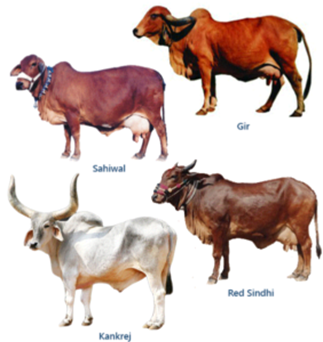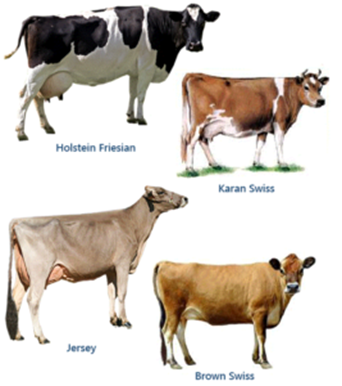Biology > Animal Husbandry > Breeds of Cows and Buffaloes
Farm management is the controlled and scientific handling of farm animals in their rearing, grooming, caring, feeding and breeding to give a much-needed boost to food production. Dairy management is the management of animals for milk and its products for human consumption. The main aim of dairy management is to deal with processes and systems that increase yield and improve the quality of milk. Bullocks are used for ploughing, harrowing, threshing, transport and drawing water from well. They provide hides, horns and hooves, and other byproducts. Their dungs are used in Gober gas (Biogas) plants for biogas generation and manure.
India is the world’s largest producer of milk. The majority of the milk consumed is also in liquid form in India. In India cattle like cow and buffalo primarily provide milk which is a perfect diet and important source of nutrients and proteins. Production of processed milk products is very less compared to developed countries. The National Dairy Development Board (NDDB) is the main agency behind the cooperative movement in India. India is now seeking joint ventures and financial participation from the private sector including foreign investment for production of milk, milk products and dairy business in India.
Lactation Period is the period of milk production between the birth of a young one and the next pregnancy and it usually lasts about 300 days.
Breeds of Cattle:
A breed is a group of one species of animals, which have the same descent and are similar in body shape, size, and structure. On the basis of utility, they are classified into three types.
- Milch Breeds: They give higher milk production. e.g. Gir, Sahiwal, Red Sindhi, Deoni.
- Draught Breeds: They have a higher capacity for work. e.g. Amruthmahal, Malvi, Nageri, Hallikar, Siri, Khillari, and Kangayam.
- General Utility Breeds: They give more milk and do have a higher capacity for work. e.g. Hariana, Ongole, Kankrej, Tharparkar
India possesses 27 good breeds of cattle and seven breeds of buffaloes. They differ from each other on the basis of body colours, horns and foreheads. They are the well-known world over for their quality of hardiness, endurance and resistance to tropical diseases.
Holstein-Friesian is an American breed which is the largest producer of milk per lactation. It has less percentage of fat. Brown Swiss breed is raised in Switzerland it has a high content of minerals and lactose and its milk is used for making cheese. Jersey is a breed which is low milk producing breed but it has more fat content. Red Dane breed from a cold region of Europe is more milk-producing breed.
Cows
Indian breeds:
Gir, Sahiwal, Red Sindhi, Thararkar, Kankrej, etc. are some high yielding varieties of Indian cattle.
|
Name |
Breed |
Found in |
Purpose |
Milk Yield per Lactation |
|
Thariparkar (White Sindhi, Grey Sindhi, Thari) |
Indigenous |
Gujarat, Rajasthan (along the Indo-Pak border covering Western Rajasthan and up to the Rann of Kutch in Gujarat. |
Food – milk |
1749-2147 kg |
|
Vechur (White Sindhi, Grey Sindhi, Than) |
Indigenous |
Kerla (Kuttanadu, Alappuzha, Kottayam, Pathanamthitta and Kasaragod districts of Kerala.) |
Food – Milk, Dung – Manure |
561 kg |
|
Red Sindhi (Malir (Baluchistan), Red Karachi and Sindhi) |
Indigenous |
Origin is in Pakistan, Orissa Tamilnadu, Bihar, Kerala and Assam states of India. |
Food – milk |
1840-2600 kg |
|
Sahiwal (Lambi Bar, Lola, Montgomery, Multani and Teli) |
Indigenous |
Punjab, Rajasthan |
Food – Milk; Dung – Manure |
2325-2750 kg |
|
Punganur |
Indigenous |
Andhra Pradesh (Punganur, Vayalpad, Madnapall and Palamaner) |
Food -Milk; Work – Draught and Transportation |
546- 1100 kg |
|
Rathi |
Indigenous |
Rajasthan (Bikaner) |
Food -Milk |
1560-2810 kg |
|
Motu (Deshi) |
Indigenous |
Odisha (Malkangiri, Motu, Kalimela, Podia |
Food –Milk Work – Draught Dung – Manure |
0- 140 kg |
|
Ongole (Nellore) |
Indigenous |
Andhra Pradesh (Nellore to Vizianagram ) |
Food –Milk Work – Draught Dung – Manure |
798 kg |
|
khariar (Deshi) |
Indigenous |
Odisha ( Nuapada, Kalahandi, Balangir, Khariar, Komna, Sinapali and Nuapada |
Food –Milk Work – Draught Dung – Manure, fuel |
0- 450 kg |
|
Hariana (Hansi) |
Indigenous |
Haryana |
Food –Milk Work – Draught and Transport |
997- 1745 kg |
|
Kankrej (Wadad or Waged,Vagadia, Talabda, Nagar,Bonnai) |
Indigenous |
Gujarat, Rajasthan |
Food –Milk Work – Draught and Transport |
1738-1800 kg |
|
Gir Bhodali, Desan, Gujarati, Kathiawari, Sorthi and Surati) |
Indigenous |
Gujarat, (Saurashtra and around Gir Forest) |
Food -Milk |
2110-3300 kg |

Exotic Breeds:
Holstein Friesian, Jersey, Swiss, etc. are some of the high yielding varieties that have been imported from abroad and reared widely in India.
|
Name |
Breed |
Found in |
Purpose |
Milk Yield per Lactation |
|
Jersey |
Crossbred |
All India |
Food -Milk |
1749-2147 kg |
|
Holstein Friesian |
Crossbred |
Hilly and Temperate Regions (All India) |
Food -Milk |
3000-3500 kg |

Improved breeds:
Some improved breeds have been developed by making a cross between two desired breeds. A cross between Sahiwal and Friesian varieties has been named as Friewal, Karan Swiss is another improved breed for milk production in large quantities.
Other Indian Breeds of Cow and Their Distributions:
- Mewati (Rajasthan)
- Hallikar (South India)
- Kangayam (Tamilnadu)
- Murrah (Haryana, Punjab, Uttar Pradesh)
Buffaloes:
Buffaloes are believed to have been domesticated around 5000 years ago in the Indus Valley. Some of the well-known dairy breeds of buffalo found in India and Pakistan are Murrah, Nili-Ravi, Kundi, Surti, Jaffarabadi, Bhadawari, Mehsana, Godawari and Pandharpuri. Despite potential advantages, little attention has been paid to buffalo improvement programs.
|
Name |
Breed |
Found in |
Purpose |
Milk Yield per Lactation |
|
Murrah |
Indigenous |
Haryana, Punjab, Delhi and Uttar Pradesh |
Food -Milk |
1360-2270 kg |
|
Jaffarabadi |
Indigenous |
Gujarat |
Food -Milk |
1300-1400 kg |
|
Bhadavari |
Indigenous |
Uttar Pradesh, Madhya Pradesh |
Food -Milk |
1100-1300 kg |
|
Surti |
Indigenous |
Gujarat |
Food – Milk |
1300-1400 kg |
|
Nagpuri |
Indigenous |
Nagpur, Madhya Pradesh |
Food- Milk |
825 kg |
|
Nili Ravi |
Indigenous |
Punjab |
Food – Milk |
2000 kg |
|
Mehsana |
Indigenous |
Gujarat |
Food – Milk |
1800-2700 kg |

Comparison Between Buffalo’s Milk and Cow’s Milk:
|
|
Buffalo Milk |
Cow Milk |
|
Fat Content |
100% more fat content than cow’s milk |
Lower in fat content than buffalo milk |
|
Nutritional value |
Extremely rich in calcium, and is a good source of minerals like magnesium, potassium, and phosphorus. |
rich in a variety of minerals, vitamins, proteins and calcium |
|
Cholesterol Level |
Less than cow’s milk |
More than buffalo’s milk |
|
Protein level |
More than cow’s milk |
Less than buffalo’s milk |
|
Vitamin level |
Buffalo metabolizes all the carotene into vitamin a, which is passed on to milk as such |
Less than buffalo’s milk |
|
Preservation |
can be preserved for longer |
preserved for less time |
|
Health Benefits |
good for healthy bones, dental health, cardiovascular health, and weight gain |
good for healthy bones, dental health, reducing obesity in children, protection from thyroid diseases, and for cardiovascular health |
|
Uses |
suitable for the manufacture of yogurt, cheese (paneer), khoa and ghee. |
suitable for the manufacture of curds, sweets, cheese |
Previous Topic: Introduction to Animal Husbandry